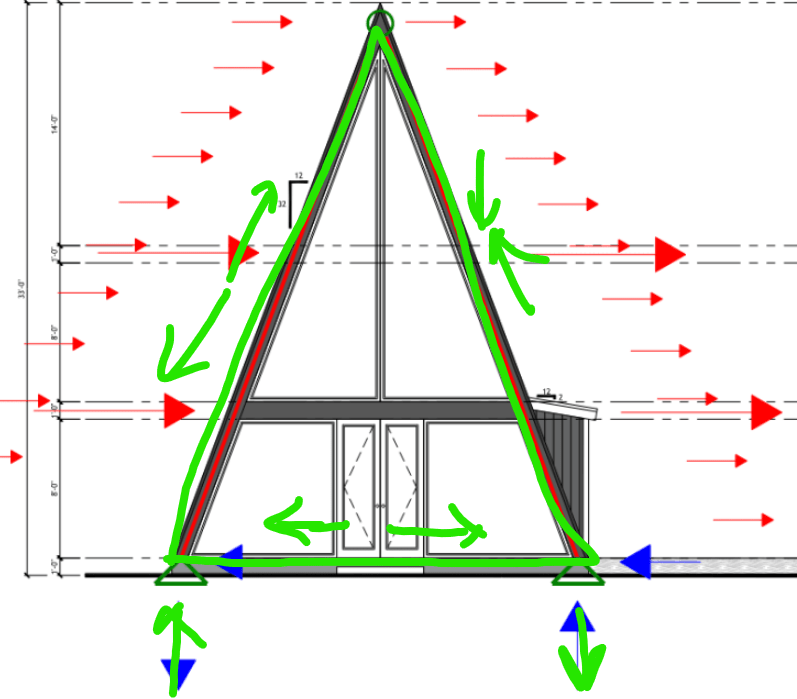R_D_W
Structural
- Nov 14, 2022
- 2
I have had multiple requests over the years for engineering of A-frame style homes with light-frame construction. How is the lateral design of this type of structure justified by modern building codes? I am specifically concerned about seismic design in the plane of the "A". They are usually full of windows on the ends of the structure, with no room for conventional wood shear walls at the ends. Shear walls don't seem appropriate anyway because the roof diaphragm is nearly vertical and wouldn't be able to transfer lateral loads to the end walls through shear action.
I have thought that I would design each "A", spaced at 24" or 48", for the small tributary lateral load to the "A". The floors (where present) would apply additional lateral load to the "A". Picture below. The triangle "A-frame" is stable with or without horizontal ties between the legs of the frame. I can rationally design all the elements and connections of this approach. Is this approach valid? Wind loading is straightforward. The big hang up I am having is what R-factor to use for determining seismic loads. ASCE 7 does not have any lateral systems that fit the bill. Is there any other documentation out there for seismic design of A-frame structures using traditional wood-frame methods?
I am trying to keep solutions simple and economical. It's a really hard sell when I tell people that their A-frame house (a style which has been around for ages) will need some steel frames because the old methods don't work under the most recent building codes. Mentioning steel usually kills the project. Unless there is some evidence out there that the A-frame style is structurally deficient in some way, there should still be a reasonable way to design the structure with some traditional wood-framed methods.
Any help or guidance is appreciated.

I have thought that I would design each "A", spaced at 24" or 48", for the small tributary lateral load to the "A". The floors (where present) would apply additional lateral load to the "A". Picture below. The triangle "A-frame" is stable with or without horizontal ties between the legs of the frame. I can rationally design all the elements and connections of this approach. Is this approach valid? Wind loading is straightforward. The big hang up I am having is what R-factor to use for determining seismic loads. ASCE 7 does not have any lateral systems that fit the bill. Is there any other documentation out there for seismic design of A-frame structures using traditional wood-frame methods?
I am trying to keep solutions simple and economical. It's a really hard sell when I tell people that their A-frame house (a style which has been around for ages) will need some steel frames because the old methods don't work under the most recent building codes. Mentioning steel usually kills the project. Unless there is some evidence out there that the A-frame style is structurally deficient in some way, there should still be a reasonable way to design the structure with some traditional wood-framed methods.
Any help or guidance is appreciated.


